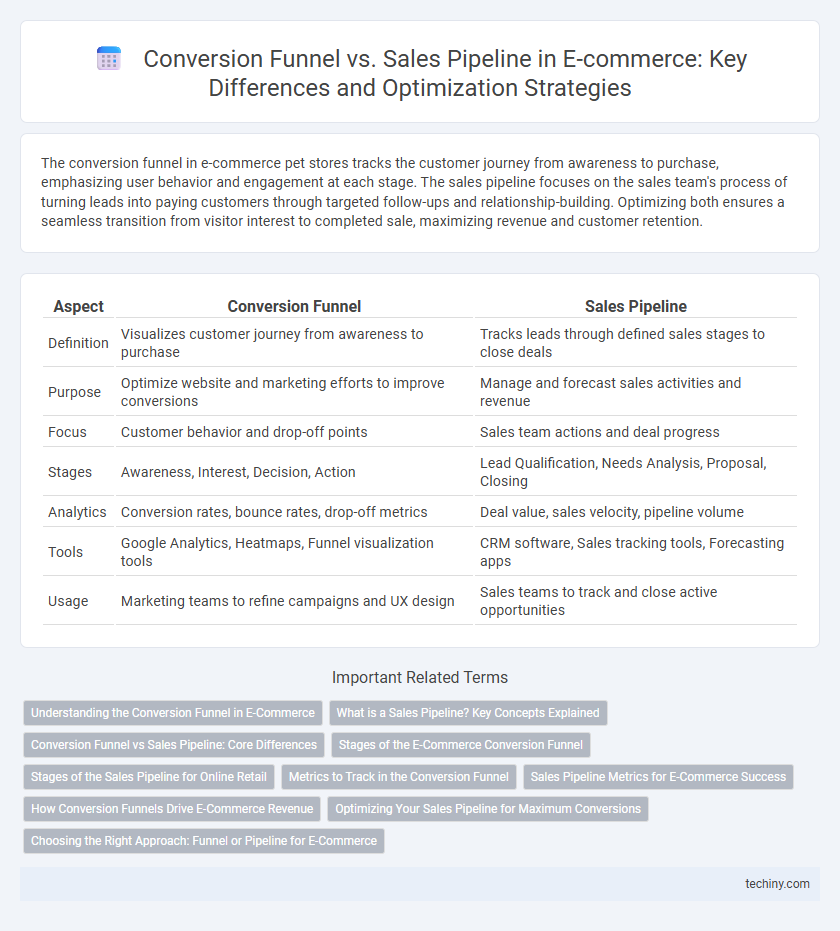The conversion funnel in e-commerce pet stores tracks the customer journey from awareness to purchase, emphasizing user behavior and engagement at each stage. The sales pipeline focuses on the sales team's process of turning leads into paying customers through targeted follow-ups and relationship-building. Optimizing both ensures a seamless transition from visitor interest to completed sale, maximizing revenue and customer retention.
Table of Comparison
| Aspect | Conversion Funnel | Sales Pipeline |
|---|---|---|
| Definition | Visualizes customer journey from awareness to purchase | Tracks leads through defined sales stages to close deals |
| Purpose | Optimize website and marketing efforts to improve conversions | Manage and forecast sales activities and revenue |
| Focus | Customer behavior and drop-off points | Sales team actions and deal progress |
| Stages | Awareness, Interest, Decision, Action | Lead Qualification, Needs Analysis, Proposal, Closing |
| Analytics | Conversion rates, bounce rates, drop-off metrics | Deal value, sales velocity, pipeline volume |
| Tools | Google Analytics, Heatmaps, Funnel visualization tools | CRM software, Sales tracking tools, Forecasting apps |
| Usage | Marketing teams to refine campaigns and UX design | Sales teams to track and close active opportunities |
Understanding the Conversion Funnel in E-Commerce
The conversion funnel in e-commerce represents the customer journey from initial website visit to final purchase, tracking user engagement at each stage such as awareness, consideration, and decision. Optimizing key metrics like click-through rates, cart abandonment, and checkout completion increases conversion rates effectively. Understanding these stages enables businesses to tailor marketing strategies, enhance user experience, and drive higher sales performance.
What is a Sales Pipeline? Key Concepts Explained
A sales pipeline is a visual representation of the stages a potential customer goes through before making a purchase in e-commerce, tracking progress from lead generation to closing the sale. Key concepts include lead qualification, nurturing, and opportunity management, which help sales teams focus on high-potential prospects and increase conversion rates. Efficient pipeline management boosts revenue forecasting accuracy and streamlines the sales process, enhancing overall e-commerce performance.
Conversion Funnel vs Sales Pipeline: Core Differences
The conversion funnel maps the customer journey from awareness to purchase, emphasizing stages like interest, consideration, and decision within e-commerce. The sales pipeline, however, tracks active sales opportunities and their progression through qualified leads, proposals, and closed deals to optimize revenue. Key differences lie in the conversion funnel's focus on user behavior and engagement metrics versus the sales pipeline's emphasis on sales activity and deal management.
Stages of the E-Commerce Conversion Funnel
The e-commerce conversion funnel consists of key stages: awareness, interest, desire, and action, guiding potential buyers from initial visit to completed purchase. This funnel emphasizes customer behavior and engagement metrics, such as click-through rates and add-to-cart actions, to optimize the shopping experience and increase conversion rates. Unlike the sales pipeline, which tracks individual prospects through sales activities, the conversion funnel focuses on aggregate user interactions and drop-off points to enhance overall online store performance.
Stages of the Sales Pipeline for Online Retail
The sales pipeline for online retail typically consists of stages such as lead generation, prospect qualification, product presentation, negotiation, and closing the sale. Each stage helps e-commerce businesses systematically track potential customers from initial interest to final purchase, ensuring targeted marketing efforts and enhanced customer engagement. Optimizing these stages increases conversion rates and drives revenue growth in competitive online marketplaces.
Metrics to Track in the Conversion Funnel
Tracking key metrics in the conversion funnel is crucial for optimizing e-commerce performance, including drop-off rates at each stage, cart abandonment percentages, and average time spent on product pages. Monitoring conversion rates from visitor to lead, lead to prospect, and prospect to customer provides insight into customer behavior and identifies bottlenecks. Analyzing metrics such as click-through rates, bounce rates, and revenue per visitor ensures targeted improvements that drive sales growth and enhance user experience.
Sales Pipeline Metrics for E-Commerce Success
Sales pipeline metrics such as lead velocity, average deal size, and win rate provide critical insights for optimizing e-commerce sales performance. Tracking the sales pipeline stages from prospecting to closing helps identify bottlenecks and improve conversion rates at each phase. Monitoring metrics like sales cycle length and customer acquisition cost enables e-commerce businesses to streamline processes and increase overall revenue efficiency.
How Conversion Funnels Drive E-Commerce Revenue
Conversion funnels in e-commerce meticulously track customer interactions from awareness to purchase, optimizing each stage to reduce drop-offs and increase completed transactions. By analyzing funnel metrics such as click-through rates, cart abandonment, and checkout completion, retailers identify bottlenecks and implement targeted strategies like personalized offers or streamlined payment processes. This focused approach directly drives e-commerce revenue by transforming prospects into paying customers more efficiently than traditional sales pipelines, which primarily emphasize lead progression without in-depth behavioral insights.
Optimizing Your Sales Pipeline for Maximum Conversions
Optimizing your sales pipeline involves analyzing each stage to identify bottlenecks and improve lead nurturing strategies, ensuring a smoother transition from prospect to customer. Implementing CRM tools enables real-time tracking of customer interactions, boosting efficiency and enabling personalized follow-ups. A well-structured sales pipeline aligns with the conversion funnel by targeting qualified leads, maximizing conversion rates, and driving consistent e-commerce revenue growth.
Choosing the Right Approach: Funnel or Pipeline for E-Commerce
Selecting the right approach between a conversion funnel and a sales pipeline depends on the e-commerce business model and customer journey complexity. Conversion funnels emphasize tracking customer behavior through stages like awareness, consideration, and purchase, optimizing for drop-off points and conversion rates. Sales pipelines focus on managing individual leads and deal progressions, suitable for B2B e-commerce with longer sales cycles and personalized follow-ups.
Conversion Funnel vs Sales Pipeline Infographic

 techiny.com
techiny.com